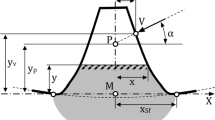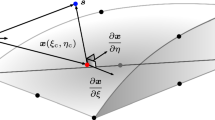Abstract
In this study, the realm of three-dimensional geometrical contact problems is delved into, with a specific focus on the scenario involving two \({C}^{1}\) gear surfaces undergoing rotational motion about two fixed axes in the spatial domain. The development of a novel mathematical model for this contact problem is encompassed by our endeavor. The foundation of our model is rooted in a new parameterization technique, which enables the reduction of the conventional system of five generally non-linear equations, each with five unknowns and one independent parameter, into a more manageable system. This streamlined approach results in a system consisting of just two equations, two unknowns, and one independent parameter. Subsequently, a back-substitution methodology is employed to explicitly derive the values for the remaining three unknowns. In a bid to ascertain the efficacy of the newly proposed model, a comparative analysis is conducted with the well-established model formulated by Litvin. Our findings demonstrate that the accuracy and stability of numerical solutions in the context of this intricate geometrical contact problem are not only enhanced by our model but also that it represents a significant advancement in the understanding and computational treatment of such scenarios.





Similar content being viewed by others
Abbreviations
- \({C}^{\mathrm{1,2}}\) :
-
Continuous function that has derivatives to the first (or second) order at least
- \({E}_{i}\) :
-
Envelope of surfaces (\(i=\mathrm{1,2}\))
- \({S}_{\mathrm{1,2}}\) :
-
Fixed coordinate system of first and second surfaces
- \({S}_{f}\) :
-
Fixed coordinate system
- \({S}_{q}\) :
-
Additional fixed coordinate system to simulate the misalignment
- \({\Sigma }_{i}\) :
-
Surface rotating around fixed axis (\(i=\mathrm{1,2}\))
- \({\overrightarrow{n}}_{i}\) :
-
Normal vector function of first (\({n}_{1}\)) and second (\({n}_{2}\)) surfaces
- \({\overrightarrow{r}}_{i}\) :
-
Radius vector from origin to the contact point
- \({v}_{i}\) :
-
Projection of \({r}_{i}\) on the center line (\(z\)-axis)
- \({u}_{i}\) :
-
Radial distance from the axis of rotation to the point of contact (\(i=\mathrm{1,2}\))
- \({a}_{12}\) :
-
Distance between center of fixed coordinate system
- \(R\) :
-
Generic rotary translation matrix \({\overrightarrow{r}}_{i}\) rotated vector function
- \({\phi }_{i}\) :
-
Angle of rotation of each surfaces around fixed axis (\(i=\mathrm{1,2}\))
- \({w}_{i}\) :
-
Axis of rotation of first and second surfaces (\(i=\mathrm{1,2}\))
- \({f}_{i}\) :
-
Vector function of parametric surface
- \(\beta\) :
-
Helix angle
- \({\alpha }_{i}\) :
-
Angle of initial involution (\(i=\mathrm{1,2}\))
References
Radzevich SP (2004) Mathematical modeling of contact of two surfaces in the first order of tangency. Math Comput Model 39(9–10):1083–1112. https://doi.org/10.1016/s0895-7177(04)90535-3
Vogel O, Griewank A, Bär G (2002) Direct gear tooth contact analysis for hypoid bevel gears. Comput Methods Appl Mech Eng 191(36):3965–3982. https://doi.org/10.1016/s0045-7825(02)00351-1
Fernandez del Rincon A, Viadero F, Iglesias M, García P, de Juan A, Sancibrian R (2013) A model for the study of meshing stiffness in spur gear transmissions. Mech Mach Theory 61:30–58. https://doi.org/10.1016/j.mechmachtheory.2012.10.008
Litvin FL, Sheveleva GI, Vecchiato D, Gonzalez-Perez I, Fuentes A (2005) Modified approach for tooth contact analysis of gear drives and automatic determination of guess values. Comput Methods Appl Mech Eng 194(27–29):2927–2946. https://doi.org/10.1016/j.cma.2004.07.031
Litvin FL, Vecchiato D, Fuentes A, Gonzalez-Perez I (2004) Automatic determination of guess values for simulation of meshing of gear drives. Comput Methods Appl Mech Eng 193(33–35):3745–3758. https://doi.org/10.1016/j.cma.2004.02.005
Litvin FL, Gonzalez-Perez I, Fuentes A, Vecchiato D, Sep TM (2005) Generalized concept of meshing and contact of involute crossed helical gears and its application. Comput Methods Appl Mech Eng 194(34–35):3710–3745. https://doi.org/10.1016/j.cma.2004.09.009
Litvin FL, Fuentes A (2004) Gear geometry and applied theory, 2nd edn. Cambridge University Press, Cambridge
Bracci A, Gabiccini M, Artoni A, Guiggiani M (2009) Geometric contact pattern estimation for gear drives. Comput Methods Appl Mech Eng 198(17–20):1563–1571. https://doi.org/10.1016/j.cma.2009.01.009
Lin C-H, Fong Z-H (2015) Numerical tooth contact analysis of a bevel gear set by using measured tooth geometry data. Mech Mach Theory 84:1–24. https://doi.org/10.1016/j.mechmachtheory.2014.09.010
Spitas C, Spitas V (2008) Direct analytical solution of a modified form of the meshing equations in two dimensions for non-conjugate gear contact. Appl Math Model 32(10):2162–2171. https://doi.org/10.1016/j.apm.2007.07.007
Spitas C, Spitas V (2011) Fast unconditionally stable 2-D analysis of non-conjugate gear contacts using an explicit formulation of the meshing equations. Mech Mach Theory 46(7):869–879. https://doi.org/10.1016/j.mechmachtheory.2011.02.010
Temirkhan M, Amrin A, Spitas V, Spitas C (2023) Convergence and accuracy problems of the conventional TCA model—critical analysis and novel solution for crowned Spur Gears. Proc Inst Mech Eng C J Mech Eng Sci. https://doi.org/10.1177/09544062231181834
Temirkhan M, Tariq HB, Kaloudis K, Kalligeros C, Spitas V, Spitas C (2022) Parametric quasi-static study of the effect of misalignments on the path of contact, transmission error, and contact pressure of crowned spur and helical gear teeth using a novel rapidly convergent method. Appl Sci 12(19):10067. https://doi.org/10.3390/app121910067
Temirkhan M, Tariq HB, Spitas V, Spitas C (2023) Parametric design of straight bevel gears based on a new tooth contact analysis model. Arch Appl Mech. https://doi.org/10.1007/s00419-023-02488-z
Acknowledgements
Authors are thankful to the editor and anonymous referees for their valuable comments and suggestions.
Author information
Authors and Affiliations
Corresponding author
Additional information
Publisher's Note
Springer Nature remains neutral with regard to jurisdictional claims in published maps and institutional affiliations.
Rights and permissions
Springer Nature or its licensor (e.g. a society or other partner) holds exclusive rights to this article under a publishing agreement with the author(s) or other rightsholder(s); author self-archiving of the accepted manuscript version of this article is solely governed by the terms of such publishing agreement and applicable law.
About this article
Cite this article
Temirkhan, M., Spitas, C. & Wei, D. A computationally robust solution to the contact problem of two rotating gear surfaces in space. Meccanica 58, 2455–2466 (2023). https://doi.org/10.1007/s11012-023-01738-2
Received:
Accepted:
Published:
Issue Date:
DOI: https://doi.org/10.1007/s11012-023-01738-2




